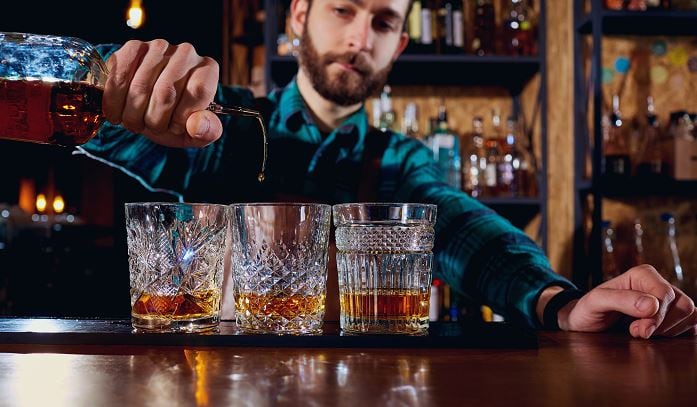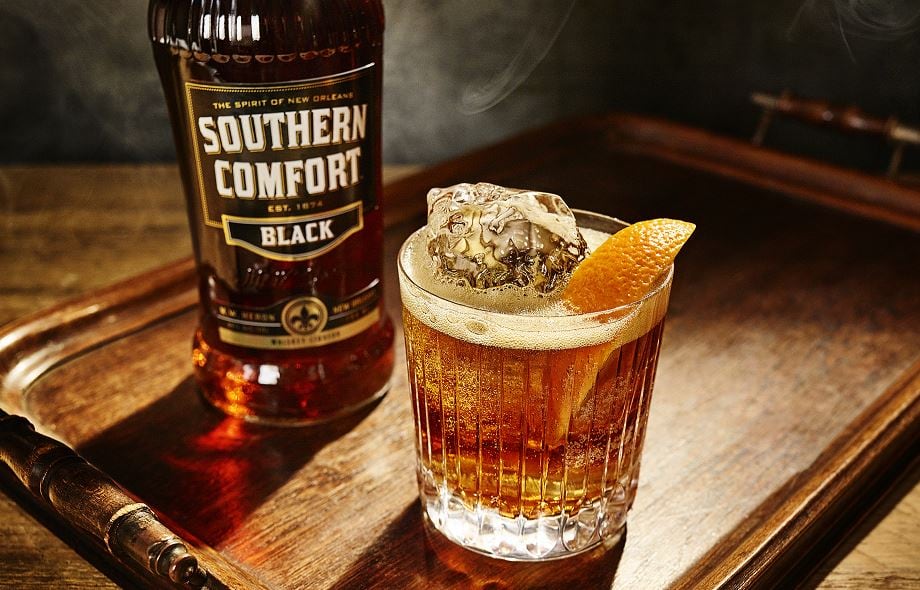The three words are too easily recalled – along with peaty, leathery and oaky – and roll off the tongue when talking about the category, but are also responsible for the perception that whisky is unwelcoming. Conversely, could we ever say whisky is light, refreshing and fun?

All that said, whisky is in a good place financially, but can do better. Total whisky sales are up 2.7% in value and 1.3% in volume terms. Within this, imported whisky sales are up 7.6% in value and 11.1% in volume – CGA & Nielsen Scantrack, 2018. The same stats show American whiskey is the hero when it comes to growth, with on-trade value sales up 4.2% and accounting for 78.6% of total imported whisky value sales.
On the surface, things look good, but when you look deeper you see there is a lot to overcome if these figures are ever to mirror the heights of vodka and gin. “Whisky tends to scare some people away,” says Giacomo Brunelli, bartender at Scarfes Bar in central London. “People look at our whisky cabinet with respect, awe and maybe a bit of fear.”
Ross Walton, head of bars and drinks development at The Restaurant Group, which owns brands including Brunning & Price and Chiquito, agrees there is an issue with perception.
“For a long time, whisky has been perceived as a premium spirit to be consumed neat or over ice,” he says. “It was generally considered to be the drink of connoisseurs or people of a certain age group, which created a barrier for new drinkers.”
Entry level whisky
Perhaps one of the more prominent growth preventions is the fact whisky has few entry levels. As Hi-Spirits managing director Dan Bolton points out: “The category has suffered at entry level in the on-trade from a lack of accessibility, which has a lot to do with the way that Scotch whisky promotes itself. It has created a mystique in order to appeal to connoisseurs, which creates barriers.”
Take a look at the state of the category now and it is clear whisky’s growth inhibitors can be overcome quite easily. First, entry-level whiskies need to be identified, talked about and used in bars. Second, we need to become more creative with our use of the spirit.
Whiskey liqueurs, such as Southern Comfort’s three variants – Original, Black and 100 Proof – are key customer drivers into the category, giving them a friendlier taste.

The 140-year-old brand has been reimagined in recent years and is embracing its New Orleans origins as well as the heritage of founder Martin Wilkes Heron. Tapping into its heritage, while inspiring bartenders to use it in more drinks, is working and can be seen in the sales figures (see box right).
American whiskeys are performing very well and quenching the desires of younger drinkers seeking easy and fun liquids. The likes of Southern Comfort and Bourbons like Buffalo Trace, are ideal market entry points. For Scotch, there are few entry-level variants, but Haig Club Clubman has been designed as an easy, drinkable spirit for mixing.
On the topic of mixing, CGA’s Mixed Drinks Report for the third quarter of 2017 showed American whiskey and a cola was the second most popular serve of its kind. It is also interesting to note that 10% of the 50 best-selling cocktails globally are whisky-based, and cocktails are growing significantly against an overall flat alcohol market.
Many bars are tying whisky into cocktail growth, including specialist Scotch whisky bar Black Rock. “Our cocktail menu helps bridge the gap between whisky drinkers and non-drinkers,” explains bar manager Thom Solberg.
Whisky fans

“We endeavour to have cocktails that are interesting enough not to scare anyone away from the category. Although we are a whisky bar, we do get lots of people coming in who aren’t whisky fans and will tell us they dislike whiskey, so it’s our job to bridge those gaps.”
Christian Tirel, UK brand ambassador for Southern Comfort, advises operators, when moving customers to another whiskey level, to use brands that are fun. “Buffalo Trace and Eagle Rare are about as authentic as Kentucky Bourbons come. They deliver credibility without coming across pretentious, as some whiskies can,” he says. “The cocktail list is a great practical way for operators to give consumers more confidence about enjoying a range of whiskies.”
Bolton, meanwhile, believes in taking people on a journey, advising operators to give clear signposts from entry level onwards. “This will give them confidence to try different brands and styles, and appreciate the range of flavours that barrel ageing and blending can deliver.”

Scarfes Bar’s Brunelli feels it is best to find common ground between yourself and a customer. “Explain to guests the flavour profile of a whisky, rather than bore them with production details,” he says. “Everyone understands flavour, so the moment you speak a common language, you make the first step in their direction and make them feel comfortable. Do not try to force a sale on them.”
But is it worth all of the effort? The Restaurant Group believes so, saying the vastness of the category provides plenty of opportunities for operators to tap into. “People are drinking less, but are happy to spend more on a single drink if they feel it is worth it,” he explains.
“A drink used to be judged on the liquid alone, but guests are now judging a drink on the experience, where flavour, provenance and point of difference all play a key role. Whisky has an abundance of these, along with a vast range of products demanding premium-selling prices, so it is a great category in which to recruit new customers.”
WHAT’S STOPPING WHISKY’S GROWTH?
Thom Solberg, bar manager, Black Rock, east London:
“Misinformation and myths. We get people asking why we stock Bourbon because, technically, it isn’t a whisky. This is something they have been presented with as a fact. So we spend a lot of time talking to people and when we get these guys an Eagle Rare or Buffalo Trace and they enjoy it, we know we’re getting somewhere.”
Nicole Sykes, bartender, Satan’s Whiskers, London:
“A lack of education. If more bartenders were educated on whisky, they could sell it to guests and start a word of mouth trail. The ABV and price of whiskies can also be intimidating. Again, education would help.”
Giacomo Brunelli, bartender, Scarfes Bar, London:
“The belief it should not be mixed is the biggest limitation to growth. As long as people are told this, they will end up trying something too strong for them and will never come back to the category.”
Ross Walton, head of bars and drinks development, The Restaurant Group:
“Whisky can be a daunting category so we have to remove some apprehensions on the spirit and come up with some long serves to entice new drinkers.”
Dan Bolton, managing director, Hi-Spirits:
“There needs to be clear signposts to take customers through the journey from entry level onwards, giving them the confidence to try different brands and styles, and appreciate the range of flavours.”
Christian Tirel, UK brand ambassador, Southern Comfort:
“The cocktail list is a great way for operators to give consumers more confidence about whiskies, with classics complemented with refreshing drinks such as Southern Comfort with lemonade and lime, and the Buffalo Trace Mint Julep served from the chiller.”
This article was sponsored by Southern Comfort brand owner Hi-Spirits and written by The Morning Advertiser.
